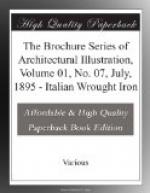[Illustration: XLIX. Wrought Iron Lantern on the Strozzi Palace, Florence.]
XLIX,
Wrought iron lantern on the Strozzi Palace, Florence.
This is one of the finest examples of Italian wrought iron work still existing, and has frequently served as a model for lanterns in recent times.
[Illustration: L. Wrought Iron Lantern on the Palazzo Guadagni, Florence.]
L.
Wrought iron lantern on the Palazzo Guadagni, Florence.
[Illustration: LI. Wrought Iron Lantern on the Palazzo Bocella, Lucca.]
LI.
Wrought iron lantern on the Palazzo BROCELLA, Lucca.
[Illustration: LII. Wrought Iron Lantern on the Palazzo Baroni nel Fillungo, Lucca.]
LII.
Wrought iron lantern on the Palazzo Baroni nel Fillungo, Lucca.
[Illustration: LIII. Wrought Iron Torch Holder, Public Square, Siena.]
LIII. Wrought iron torch-bearer, Siena.
This is attached to a column which bears the group representing Romulus and Remus, and which is situated in the public square near the cathedral.
[Illustration: LIV. Wrought Iron Torch Holder, Siena.]
[Illustration: LV. Wrought Iron Torch Holder, Siena.]
LIV and LV. Wrought iron torch-bearers, Siena.
These two plates represent the same torch-holder, viewed from front and side.
[Illustration: LVI. Wrought Iron Torch Holder, Siena.]
LVI. Wrought iron torch-bearer, Siena.
This together with the preceding example are reproductions of old work.
Reproduction of Architects’ Drawings.
The development of photographic processes for the reproduction of drawings which has taken place within the past few years has led to a remarkable increase in the publication of architects’ designs, both in the technical journals and in the popular magazines and daily press. Undoubtedly the recent progress of architectural design in America is largely due to the opportunity for comparison thus placed within the reach of architects and draughtsmen who could not otherwise place their productions beside those of their fellows. So important has this become that an architectural paper is now usually judged almost entirely upon the quality of its illustrations, the text matter being not only secondary, but in some cases serving only as a vehicle for the plates. In fact, some of the most valuable and most highly esteemed architectural publications are entirely devoid of text.




